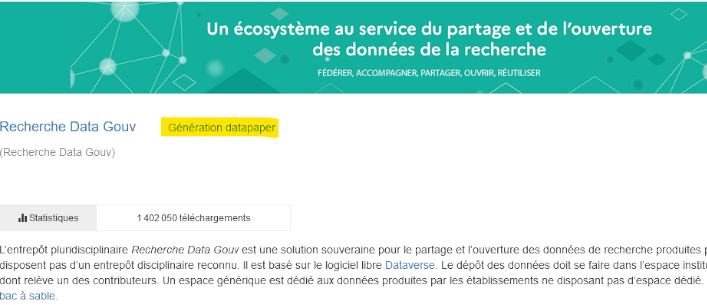Create a draft data paper in a few clicks
Also called a "data article", the data paper is one of the still emerging forms of academic publications. Like any scientific paper, it is peer-reviewed and must meet well-defined requirements.
Its purpose is to describe a dataset in detail, emphasizing the method of data construction and their potential for reuse. Unlike a traditional scientific paper, the data paper does not provide research results and generally does not contain any discussion or conclusion. On the other hand, it facilitates the reproducibility and reuse by making the data intelligible and citable. Moreover it offers the opportunity to value the work of all actors who have contributed to their production.
Recherche Data Gouv provides researchers with a tool to generate a draft data paper.
To use this tool, it is necessary to have previously deposited the dataset to be valorised in the Recherche Data Gouv repository. This is a mandatory step in order to assign a DOI (persistant identifier) to the dataset. It should be noted that the more complete the metadata entered, the more complete the draft data paper will be!
Then, go to the homepage of the Recherche Data Gouv repository and select ‘Generation datapaper’.

Two fields are to be filled in:
- the template. At the moment, only two templates are available: a generic pattern entitled "Recherche Data Gouv", and the one corresponding to the requirements of Data in brief, a data journal edited by Elsevier. It is planned to propose alternative templates.
- the DOI of the dataset
The generated file is a text document ready to be edited. Indeed, this is only a rough draft, constructed from the metadata and description provided at the time of filing the dataset. In order to meet the requirements of the journal, this draft will have to be supplemented, in particular with the potential for reuse of the data: how could they be used by other research teams, including in other disciplines? What is their added value?...
Is your data paper finished and ready to be published in an academic journal? Do not forget to:
- deposit the version of your accepted author manuscript in the HAL open archive, choosing as document type: Journal article > Data paper
- mention the data paper, by its HAL identifier, in the notice of the corresponding dataset in the Recherche Data Gouv repository, by entering the metadata ‘Related publication’.
For all these steps, it is recommended to be accompanied by a data management cluster.
Additional resources
- Tutoriel : générer une ébauche de data paper [video]. Recherche Data Gouv, updated 21/10/2024 (accessed 2024-10-21).
- Tang, Cathy, RENATIS. L’entrepôt Recherche Data Gouv au service des data papers [video]. Canal-U, 24/10/2023 (accessed 2024-10-21).
- Papin, Élodie. Le concept d'article de données. ADOC Lorraine, 2023. DOI : 10.5281/zenodo.10254897
To discover the evolutions of the data paper generation tool, follow online the next C@fé Renatis on 5 November 2024.
